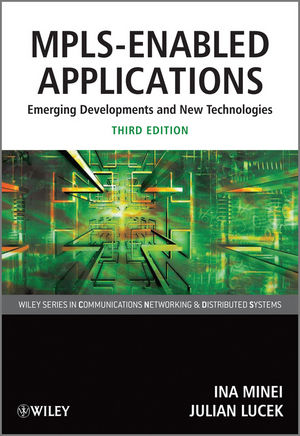MPLS-Enabled Applications: Emerging Developments and New Technologies, 3rd EditionISBN: 978-0-470-66545-9
Paperback
632 pages
January 2011
 This is a Print-on-Demand title. It will be printed specifically to fill your order. Please allow an additional 10-15 days delivery time. The book is not returnable.
|
||||||
Foreword.
Preface.
Acknowledgements.
Part One.
1 Foundations.
1.1 Historical perspective.
1.2 Current trends.
1.3 MPLS mechanisms.
1.4 Conclusion.
1.5 References.
1.6 Further reading.
1.7 Study questions.
2 Traffic Engineering with MPLS (MPLS-TE).
2.1 Introduction.
2.2 The business drivers.
2.3 Application scenarios.
2.4 Setting up traffic-engineered paths using MPLS-TE.
2.5 Using the traffic-engineered paths.
2.6 Deployment considerations.
2.7 Using traffic engineering to achieve resource optimization.
2.8 Offline path computation.
2.9 Conclusion.
2.10 References.
2.11 Further reading.
2.12 Study questions.
3 Protection and Restoration in MPLS Networks.
3.1 Introduction.
3.2 The business drivers.
3.3 Failure detection.
3.4 End-to-end protection.
3.5 Local protection using fast reroute.
3.6 Link protection.
3.7 Node protection.
3.8 Additional constraints for the computation of the protection path.
3.9 Interaction of end-to-end protection and fast reroute.
3.10 Deployment considerations for local protection mechanisms.
3.11 IP and LDP FRR.
3.12 Conclusion.
3.13 References.
3.14 Further reading.
3.15 Study questions.
4 MPLS DiffServ-TE.
4.1 Introduction.
4.2 The business drivers.
4.3 Application scenarios.
4.4 The DiffServ-TE solution.
4.5 Extending the DiffServ-TE solution with multiclass LSPs.
4.6 Conclusion.
4.7 References.
4.8 Further reading.
4.9 Study questions.
5 Interdomain Traffic Engineering.
5.1 Introduction.
5.2 The business drivers.
5.3 Setting up interdomain TE LSPs.
5.4 Interprovider challenges.
5.5 Comparison of the LSP setup methods.
5.6 Conclusion.
5.7 References.
5.8 Further reading.
5.9 Study questions.
6 MPLS Multicast.
6.1 Introduction.
6.2 The business drivers.
6.3 P2MP LSP mechanisms.
6.4 LAN procedures for P2MP LSPs.
6.5 Coupling traffic into a P2MP LSP.
6.6 MPLS fast reroute.
6.7 Ingress redundancy for P2MP LSPs.
6.8 P2MP LSP hierarchy.
6.9 Applications of point-to-multipoint LSPs.
6.10 Conclusion.
6.11 References.
6.12 Study questions.
Part Two.
7 Foundations of Layer 3 BGP/MPLS Virtual Private Networks.
7.1 Introduction.
7.2 The business drivers.
7.3 The overlay VPN model.
7.4 The peer VPN model.
7.5 Building the BGP/MPLS VPN solution.
7.6 Benefits of the BGP/MPLS VPN solution.
7.7 References.
7.8 Further reading.
7.9 Study questions.
8 Advanced Topics in Layer 3 BGP/MPLS Virtual.
Private Networks.
8.1 Introduction.
8.2 Routing between CE and PE.
8.3 Differentiated VPN treatment in the core.
8.4 Route reflectors and VPNs.
8.5 Scalability discussion.
8.6 Convergence times in a VPN network.
8.7 Security issues.
8.8 QoS in a VPN scenario.
8.9 IPv6 VPNs.
8.10 Conclusion.
8.11 References.
8.12 Further reading.
8.13 Study questions.
9 Hierarchical and Inter-AS VPNs.
9.1 Introduction.
9.2 Carriers’ carrier – service providers as VPN customers.
9.3 Multi-AS backbones.
9.4 Interprovider QoS.
9.5 Conclusion.
9.6 References.
9.7 Further reading.
9.8 Study questions.
10 Multicast in a Layer 3 VPN.
10.1 Introduction.
10.2 The business drivers.
10.3 mVPN – problem decomposition.
10.4 The original multicast solution – PIM/GRE mVPN (draft-rosen).
10.5 NG multicast for L3VPN – BGP/MPLS mVPN(NG mVPN).
10.6 Comparison of PIM/GRE and BGP/MPLS mVPNs.
10.7 Conclusion.
10.8 References.
10.9 Further reading.
10.10 Study questions.
11 Advanced Topics in BGP/MPLS mVPNs.
11.1 Introduction.
11.2 BGP/MPLS mVPN – inter-AS operations.
11.3 Support of PIM DM in BGP/MPLS mVPN.
11.4 Discovering the RP – auto-RP and BSR support in BGP/MPLS mVPN.
11.5 Implementing extranets in BGP/MPLS mVPN.
11.6 Transition from draft-rosen to BGP/MPLS mVPNs.
11.7 Scalability discussion.
11.8 Achieving multicast high availability with BGP/MPLS mVPN.
11.9 Internet multicast service using the BGP/MPLS mVPN technology.
11.10 Conclusion.
11.11 References.
11.12 Study questions.
12 Layer 2 Transport over MPLS.
12.1 Introduction.
12.2 The business drivers.
12.3 Comparison of Layer 2 VPNs and Layer 3 VPNs.
12.4 Principles of Layer 2 transport over MPLS.
12.5 Forwarding plane.
12.6 Control plane operation.
12.7 Admission control of Layer 2 connections into network.
12.8 Failure notification mechanisms.
12.9 Multi-homing.
12.10 Layer 2 interworking.
12.11 Circuit cross connect (CCC).
12.12 Point-to-multipoint Layer 2 transport.
12.13 Other applications of Layer 2 transport.
12.14 Conclusion.
12.15 References.
12.16 Study questions.
13 Virtual Private LAN Service.
13.1 Introduction.
13.2 The business drivers.
13.3 VPLS mechanism overview.
13.4 Forwarding plane mechanisms.
13.5 Control plane mechanisms.
13.6 LDP and BGP interworking for VPLS.
13.7 Interprovider Option E for VPLS.
13.8 Operational considerations for VPLS.
13.8 Conclusion.
13.9 References
13.10 Study questions. Part Three.
14 Advanced protection and restoration: protecting the service.
14.1 Introduction.
14.2 The business drivers.
14.3 Failure scenarios.
14.4 Existing solutions.
14.5 Protecting the egress - local protection solution.
14.6 Conclusion.
14.7 References.
14.8 Study questions.
15 MPLS Management.
15.1 Introduction.
15.2 Management – why and what.
15.3 Detecting and troubleshooting failures.
15.4 Configuration errors.
15.5 Visibility.
15.6 Conclusion.
15.7 References.
15.8 Further reading.
15.9 Study questions.
16 MPLS in Access Networks and Seamless MPLS.
16.1 Introduction.
16.2 The business drivers.
16.3 Models for MPLS deployment in access networks.
16.4 Seamless MPLS Mechanisms.
16.5 Conclusions.
16.6 References.
16.7 Study questions.
17 MPLS Transport Profile (MPLS-TP).
17.1 Introduction.
17.2 The business drivers.
17.3 Requirements for a transport profile for MPLS.
17.4 MPLS-TP functionality.
17.5 Deployment considerations.
17.6 Misconceptions about MPLS-TP.
17.7 Conclusion.
17.8 References.
17.9 Study quetions.
18 Conclusions.
18.1 Introduction.
18.2 Network convergence.
18.3 Interaction with client edge equipment.
18.4 Interprovider capability.
18.5 MPLS in the data communications network (DCN).
18.6 MPLS in mobile networks
18.7 MPLS in the enterprise.
18.8 Final remarks.
18.9 References.
Appendix A – Selected backhaul scenarios in MPLS-based access networks
Appendix B – MPLS resources.
Appendix C – Solutions to Selected Study Questions.
Appendix D: Acronyms.
Index.



